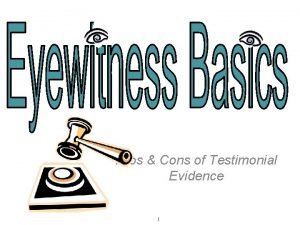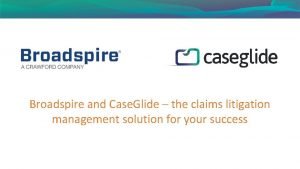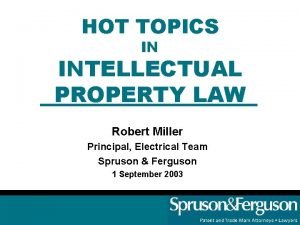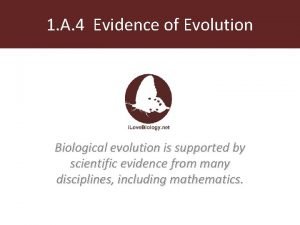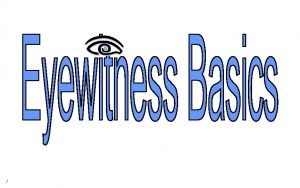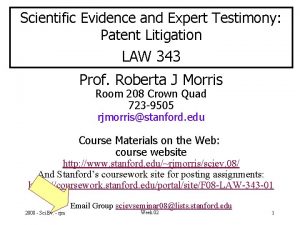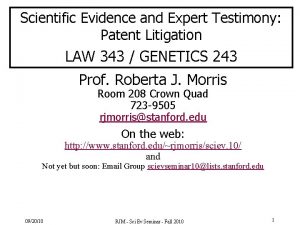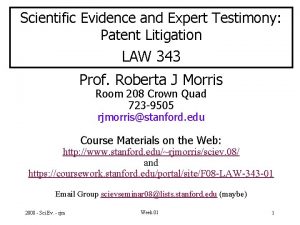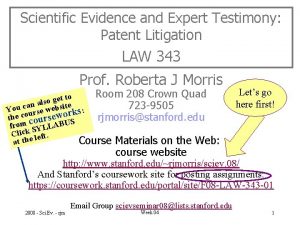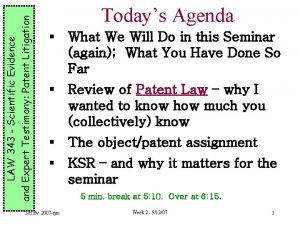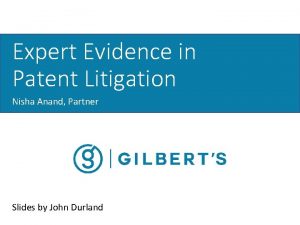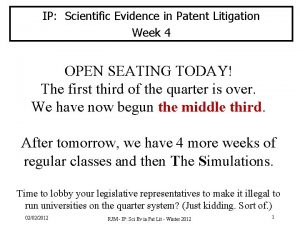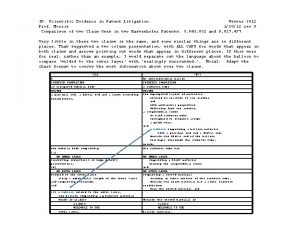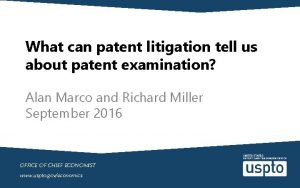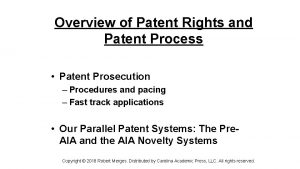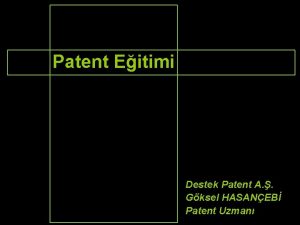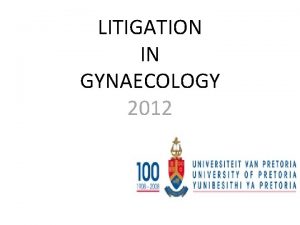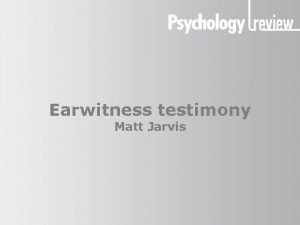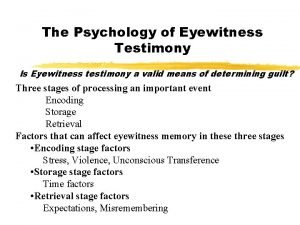Scientific Evidence and Expert Testimony Patent Litigation LAW
























- Slides: 24

Scientific Evidence and Expert Testimony: Patent Litigation LAW 343 / GENETICS 243 Prof. Roberta J. Morris Room 208 Crown Quad 723 -9505 rjmorris@stanford. edu scievseminar 09@lists. stanford. edu 2009 - Sci. Ev. - rjm Week 02 1

Today’s Agenda • Handouts/Handbacks/Handins – HO: Replacement p. 3 of student list; 5, 000 cover sheet; Calculating Expiration Dates. HB/HI: Your How-the’s • Review of / Introduction to Patent Law - the object-or-case patent assignment - the start of the introduction to patent law - the Hologic claim construction assignment • Hologic – Claim 1 – parts of a claim; reformatting problems (Start on this no later than 5: 45) Next Week: No classes for law students. Therefore no assignment. Class for Genetics 243, however. Optional review session, open to everyone. Topic to be discussed: Speak up now, or send suggestions by email. 2009 - Sci. Ev. - rjm Week 02 2

Communications and Websites; Word Police Coursework v. Blog v. Email? Any thoughts? ADDED AFTER CLASS: Democratic Choice: Coursework. (Email is only used in special situations. ) In patent law, the word INFRINGE takes a direct object. Anyone who says INFRINGE ON in this class is making a big mistake. And while the Word Police are patrolling, remember that a patent has a specification, no S. If you have two patents, you have specification. S, but that’s still one per. 2009 - Sci. Ev. - rjm Week 02 3

Patent Law Questions Other good research: more. Guillaume, than Matt T, Matt B Why choose a patent whose number is 5, 000? - Bum. Q’s answer (good research!) Let’s look at 5, 000, and calculate its expiration date. Handouts. - Design patents and Reissue patents v. Utility Patents Yesterday the Patent Office issued D 601, 325; Re. 40, 925; and PP 20, 374. 7. 6 M in utility patents is only a few weeks away. 2009 - Sci. Ev. - rjm Week 02 4

Patent Law Questions {From TIFFANY} How does a REISSUE differ from the 3 kinds of continuing applications: continuations, divisionals and continuations-in -part? Obvious Q. How do they differ from each other. A. Later. Matt’s Q: How does a REISSUE differ from the ORIGINAL? A. Later. My question to you, is there any other way besides REISSUE that an issued patent can be changed? Another to learn, and avoid using for a while. 2009 - Sci. Ev. - rjm Week 02 5

More Information than You Need (“MITYN”? ): This time about Plant Patents {Tiffany’s Question} Why is PLANT not marked as a term of art? {My questions} What IS a term of art? Are the uninitiated as likely to misuse “plant patent” as they are “design patent” “reissue” and even “utility patent”? Why or why not? Compare the PTO’s narrative with the statute 35 U. S. C. 161 Patents for plants. Whoever invents or discovers and asexually reproduces any distinct and new variety of plant, including cultivated sports, mutants, hybrids, and newly found seedlings, other than a tuber propagated plant or a plant found in an uncultivated state, may obtain a patent therefor, subject to the conditions and requirements of this title. The provisions of this title relating to patents for inventions shall apply to patents for plants, except as otherwise provided. (Amended Sept. 3, 1954, 68 Stat. 1190. ) 2009 - Sci. Ev. - rjm Week 02 6

What matters in the PATENT-in-SUIT v. Prior Art Patents and Patents Practiced by [the other side] (Accused Infringers/Potential Licensees) What does “patent-in-suit” mean? What does it mean to “assert” a patent? What else besides patents can be prior art? How does that help you remember whether you need to care about the CLAIMS of a prior art patent? Sometimes a patent owner or patent applicant SHOULD care about the claims of a prior art patent. When? 2009 - Sci. Ev. - rjm Answer: when it MIGHT be the patent-in-suit; when it might be ASSERTED. (And how would that happen? ) Week 02 7

What matters in the PATENT-in-SUIT v. Prior Art Patents and Patents Practiced by [the other side] (Accused Infringers/Potential Licensees) Situation A Patent-in-suit = NEW Prior Art Patent = OLD Situation B Patent-in-suit = OLD Patent on accused device = NEW Is the New patent valid Is the Old patent infringed by over the Old patent? someone practicing the New patent? New Patent Look at New's CLAIMS Look at New's SPECIFICATION (to see what people do who would PRACTICE New’s invention) Old Patent Look at Old's CLAIMS SPECIFICATION (to see what it "teaches") Q. When do you look at the CLAIMS? A. When the patent is ____ 2009 - Sci. Ev. - rjm Week 02 8

Claims, Broad and Narrow • BROAD claims are SHORT • NARROW claims are LONG Length (in words) Patent Claims WHY? Explain! Cf. Emily’s question about “vague wording. ” Breadth aka “scope” 2009 - Sci. Ev. - rjm Week 02 9

Your Patented Objects/Cases Last week you were asked to highlight two phrases in your claim that “you think may be important” and then you were asked to find those phrases in the specification. What did you observe? Have you looked at what your colleague said about your claim? What was good about having someone comment on your work? What was not? What else would you have liked to comment on, either in your patent or in your colleague’s claim 1? 2009 - Sci. Ev. - rjm Week 02 10

Your Reformatting Generally, EXCELLENT! Thoughtful! Serious! Some common problems: - deleting/changing/rearranging the text. That is NOT ALLOWED. The point is to QUOTE the claim exactly but to make it easier to understand it, see its flaws, figure out how to attack it, etc. - indenting rightward without enough thought. See Hologic claim analysis ahead. As stated in FORMAT. DOC, rote does not work. New concepts: The parts of claim: preamble, transitional phrase, body. 2009 - Sci. Ev. - rjm Week 02 11

Your Patented Objects/Cases and your Questions about Law* and about the Hologic Decision • Your Object/Case and patent and its claim 1 – what you liked, what surprised you, what mystified you, etc. • Comments on someone else’s claim; on the claim itself, on the exercise of looking at someone else’s reformatting • Your questions/answers from last week’s review of patent law • The HOLOGIC claim construction Choose 1 of the above but please be different from your predecessor. Everyone else: please ask questions. * Patent law only. We can talk about (T) and (C) during breaks. 2009 - Sci. Ev. - rjm Week 02 Matt. T Bum. Q Dmitry Aaron Ryan David Guillaume Matt. P Riti Emily Tiffany Matt. B Denise Ben Randomized by the Randomizer 12

Hologic Claim 1 1. Apparatus for delivering radioactive emissions to a body location with a uniform radiation profile, comprising: (a) a catheter body member having a proximal end and distal end; (b) an inner spatial volume disposed proximate the distal end of the catheter body member; (c) an outer, closed, inflatable, chamber defined by a radiation transparent wall affixed to the body member proximate the distal end thereof in have a claim that did surrounding relation to the inner. Did spatialanyone volume with a predetermined constant spacing between said NOT inner spatial and the radiation use volume the word COMPRISING? transparent wall; (d) a material containing a radionuclide(s) disposed in one of the inner spatial volume and outer chamber; and (e) means disposed in the other of the inner spatial volume and outer chamber for rendering uniform the radial absorbed dose profile of the emissions from the one of the inner spatial volume and outer chamber containing the radionuclides. 2009 - Sci. Ev. - rjm Week 02 13

The Parts of a Claim 1. Apparatus for delivering radioactive emissions to a body location with a uniform radiation profile, comprising: Everything up to the TRANSITIONAL PHRASE is the PREAMBLE Everything after the TRANSITIONAL PHRASE is the BODY Anything The 3 most-frequently-used transitional pharses are: in this - comprising OPEN color - consisting of CLOSED - consisting essentially of CLOSED except OPEN to additional things that do not affect the PROPERTIES of the claimed invention. (Only found in COMPOSITION OF MATTER claims. ) Why the double OPEN: The claim READS ON anything with AT LEAST the claimed elements. The claim has elements A B and C. negative? Why Prior Art shows A B C and D. Claim is INVALID not just say Accused device has A B C and E F and G. Claim is INFRINGED. VALID? CLOSED: The claim READS ON only what has exactly those elements and nothing more. The claim has elements A B and C. Prior Art shows A B C and D. Claim is NOT INVALID Accused device has A B C and D. Claim is NOT INFRINGED. 2009 - Sci. Ev. - rjm Week 02 14

OPEN Claims (“comprising, ” or sometimes “having”) The claim READS ON anything with AT LEAST the claimed elements. The claim has elements A B and C. The accused device has A B C and D (and so on). The claim is INFRINGED. We initiates will say, “Additional elements do not take you out of infringement. ” 2009 - Sci. Ev. - rjm Week 02 15

OPEN Claims and READING ON I think of the concept of READING ON in a visual way. It requires a 1: 1 correspondence between the claim and [the other], but without taking into consideration anything EXTRA that is not in the claim. 2009 - Sci. Ev. - rjm Week 02 CLAIM X: “A whosits COMPRISING: ” ACCUSED DEVICE or PRIOR ART A A B B C C - D 16

OPEN Claims – cont’d What READING ON looks like CLAIM X: “A whosits COMPRISING: ” ACCUSED DEVICE or PRIOR ART A A B B C C - D It’ st he CL AI M , s tu pi d. What about “anything extra” that is mentioned Ø in other claims? Ø in the specification? Ø in the product the PO marks with this patent number (aka the “commercial embodiment”)? Two more pairs of concepts you will need to understand are LITERAL INFRINGEMENT/INFRINGEMENT UNDER THE DOCTRINE OF EQUIVALENTS, and ANTICIPATION/OBVIOUSNESS. For now, let’s consider only the first (big red) term in each pair. 2009 - Sci. Ev. - rjm Week 02 17

OPEN Claims – cont’d for ANTICIPATION OPEN: The claim READS ON anything with AT LEAST the claimed elements. The claim has elements A B and C. Prior Art shows A B C and D. Claim is INVALID Accused device has A B C and D. Claim is INFRINGED. We initiates say, “That which [literally] infringes if after, anticipates if before. ” What READING ON looks like LITERALLY 2009 - Sci. Ev. - rjm Week 02 CLAIM X: “A whosits COMPRISING: ” ACCUSED DEVICE or PRIOR ART A A B B C C - D 18

OPEN Claims 2 more sample claim charts CLAIM X: “A whosits COMPRISING: ” ACCUSED DEVICE A A B B C C’ D D CLAIM ACCUSED DEVICE A A B B - D E - C != C’ but they are variants/similar. (Those are not TOAs; they are ordinary words. ) Is the claim LITERALLY INFRINGED or not? Is the claim INFRINGED OR NOT? What else might you want to know? 2009 - Sci. Ev. - rjm Week 02 19

READING ON != READING IN “READING ON” is what you have to do to evaluate validity and infringement. READING IN – used in the phrase “reading in a limitation from the specification into a claim” is a SIN. 2009 - Sci. Ev. - rjm Week 02 20

Hologic Claim 1 - Preamble 1. Apparatus for delivering radioactive emissions to a body location with a uniform radiation profile, comprising: First, as always, break the words into phrases. These breaks are preliminary. You start to see what modifies what, etc. Apparatus for delivering radioactive emissions to a body location with a uniform radiation profile Which word is modified by the phrase “with a uniform radiation profile"? Is it APPARATUS, DELIVERING, EMISSIONS, or LOCATION? If you don’t know for sure, wordsearch the patent. 2009 - Sci. Ev. - rjm Week 02 21

Hologic Claim 1 - Clauses A and B (a) a catheter body member having a proximal end and distal end; (b) an inner spatial volume disposed proximate the distal end of the catheter body member; (a) and (b) are both noncontroversial. It's good practice to break them down and place the constituent phrases at the best horizontal position, but it’s not going to be hugely important. REMINDER: Why do catheter claims (and other things, too) always recite a PROXIMAL and a DISTAL end? Or an INNER and OUTER SURFACE? Or obvious things like that? In catheter-speak: Proximal is by the Doctor and Distal is by the Patient 2009 - Sci. Ev. - rjm Week 02 22

Hologic Claim 1 - Clause C (c) an outer, closed, inflatable, chamber defined by a radiation transparent wall affixed to the body member proximate the distal end thereof in surrounding relation to the inner spatial volume with a predetermined constant spacing between said inner spatial volume and the radiation transparent wall; 2009 - Sci. Ev. - rjm Week 02 Which noun preceding the phrase "in surrounding relation to the inner spatial volume" does that phrase modify: chamber, wall, member or end? Same problem for the phrase "with a predetermined constant spacing. . " Which noun has such a spacing: volume or one of the preceding 4? 23

Next Week, and the Week after That 10/07: ? ? 10/14: BSC v. Cordis. Claim 1 was discussed in DOCS/FORMAT. DOC. Readings selected from Trial Transcript, Claim Construction Order, File History 2009 - Sci. Ev. - rjm Week 02 24
 Testimonial evidence.
Testimonial evidence. How is a scientific law different from a scientific theory?
How is a scientific law different from a scientific theory? Litigation project management
Litigation project management Case glide
Case glide Association of litigation support professionals
Association of litigation support professionals Research & litigation support
Research & litigation support Newton's first law and second law and third law
Newton's first law and second law and third law Newton's first law
Newton's first law Hot topics in patent law
Hot topics in patent law Difference between class and individual evidence
Difference between class and individual evidence Boyles law
Boyles law Charles law constant
Charles law constant Primary evidence vs secondary evidence
Primary evidence vs secondary evidence Primary evidence vs secondary evidence
Primary evidence vs secondary evidence Primary evidence vs secondary evidence
Primary evidence vs secondary evidence Primary evidence vs secondary evidence
Primary evidence vs secondary evidence Jobs vancouver
Jobs vancouver Is fiber class evidence
Is fiber class evidence Class vs individual evidence
Class vs individual evidence Class and individual evidence
Class and individual evidence Ecological fallacy meaning
Ecological fallacy meaning Invetsin
Invetsin Fish tail bird
Fish tail bird Scientific inquiry vs scientific method
Scientific inquiry vs scientific method Eyewitness testimony pros and cons
Eyewitness testimony pros and cons
